Only Apple personnel and a few others really know what Apple will
unveil at Tuesday's town hall special event at Cupertino with the
"focus on notebooks".
The hottest talking points are speculation about an $800 entry-level
MacBook, a new revolutionary manufacturing process using lasers and
water-jets to fabricate notebook cases from solid blocs of aluminum,
new 16:9 aspect ratio display
screens, perhaps Blu-ray optical drives.
A price cut to $800 would amount to $300 off the current entry-level
MacBook, which would be huge for a product in the same market slot with
the same or better level of power and features as the outgoing current
MacBook. I guess it could happen. Given the present firestorm engulfing
the world economy, desperate times could equal desperate measures.
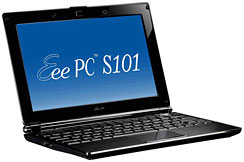
ASUS Eee PC S101
However, I'm more inclined to think that an $800 Mac notebook might
a new product, Apple's take on the netbook motif
that has proved so wildly successful on the Windows/Linux PC side
pioneered by Asustek (a.k.a. ASUS)
with its Eee PC
machine, which has been followed by entries in the category from most
of the major players.
IMHO, Apple needs to have an entry in the netbook category if it
wants to keep its laptop momentum going, especially now with the
economy in the dumpster and money for discretionary purchases like
computers tightening sharply.
A week or two ago, it was reported that the only non-netbooks on
Amazon's list of top 20 selling computers were MacBooks, leading some
to infer an indication that Apple doesn't need to concern itself about
the netbook phenomenon and would risk cannibalizing its own sales
should it release a netbook.
I disagree.
Apple certainly dominates notebook sales at Amazon, but you can't
extrapolate from that that people shopping for netbooks are considering
the MacBook as an option - only that MacBook sales are doing well
against other notebooks.
Netbook shoppers are, one can assume, mainly shopping on price, but
also looking for lightweight, compact computers with a small physical
footprint, a category which Apple vacated when the 12" PowerBook was discontinued in May 2006 -
and so far has left vacant. The expensive, feature-compromised, and
connectivity-challenged MacBook Air does not remotely fill
the gap.
Netbooks Are Hot
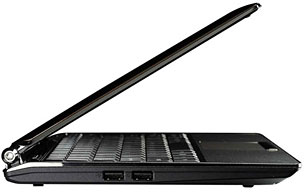 Consequently, netbooks are a marketing phenomenon Apple can't
afford to ignore, with Amazon's best-selling
laptops list dominated by $400 to $600 devices (the MacBook being
the sole exception): 3 from Asustek, 4 from Acer, 1 from HP, and 1 from
MSI this morning (the 2.4 GHz white MacBook at #8
completes the top 10). Dell and HP have also climbed aboard the netbook
train, and entering what we could euphemistically call a protracted
period of "economic uncertainty," a continued healthy market for
low-priced laptops seems one of the more certain outlooks.
Consequently, netbooks are a marketing phenomenon Apple can't
afford to ignore, with Amazon's best-selling
laptops list dominated by $400 to $600 devices (the MacBook being
the sole exception): 3 from Asustek, 4 from Acer, 1 from HP, and 1 from
MSI this morning (the 2.4 GHz white MacBook at #8
completes the top 10). Dell and HP have also climbed aboard the netbook
train, and entering what we could euphemistically call a protracted
period of "economic uncertainty," a continued healthy market for
low-priced laptops seems one of the more certain outlooks.
Many netbooks sell for less than $500 (15 of Amazon's top 16, the
MacBook being the only exception) with 1 GB of RAM, a 16-20 GB solid
state drive or a 160 GB hard drive, WiFi, and a built-in webcam.
ThinkPanmure analyst Vijay Rakesh recently weighed in on the
topic, trimming estimates on both Apple and Intel with an eye to an
anticipated slowdown in the notebook market and increasing competition
form the netbook sector.
"We believe the netbook market is starting to make inroads into the
core notebook market as a more price-conscious consumer opts for the
cheaper alternative," Rakesh wrote in an Intel note, also noting that
that checks with retailers find netbook sales "swamping core notebook
sales . . . with netbooks ramping up while core notebooks are
slowing down and potentially slowing down further."
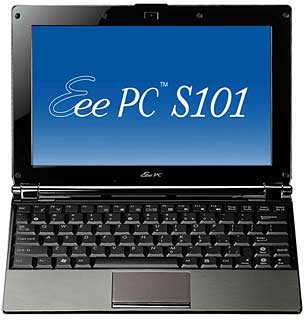 Apple
needs to cover this vulnerability, if not in tomorrow's announcement,
at least by Macworld Expo in January, if it wants to maintain its
laptop momentum (at least proportionately) in what will almost
certainly be a shrinking personal computer market over the next year or
two.
Apple
needs to cover this vulnerability, if not in tomorrow's announcement,
at least by Macworld Expo in January, if it wants to maintain its
laptop momentum (at least proportionately) in what will almost
certainly be a shrinking personal computer market over the next year or
two.
The competition is already upping the ante. Last week Asustek
launched an upmarket version of the Eee PC with its stylish and very
attractive S101 model, available in three fashion colors - brown,
champagne, and graphite - and highlighted with details like "premium
Infusion finishes" and crystal-adorned hinges in a package weighing
just 1 kg (2.4 lb.) and 18-25 cm (0.7-1.0") thick - not quite as
slim as the MacBook Air, but in the same ballpark.
Asus touts the S101 as the "pinnacle of netbook computing." And
while it comes at a higher price - $699 - than the regular Eee PC, it's
lighter, nearly as thin, and cheaper than a MacBook Air. In my opinion,
it looks nicer and has a much more practical and real-world useful
specification.
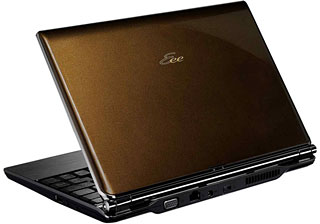 The
S101 trounces the Air in terms of most aspects and features. It
supporting not only WiFi 802.11n and Bluetooth 2.0 connectivity, but
also including a VGA port (D-sub 15-pin for external monitor), 3 USB
2.0 ports (to the MacBook Air's overworked single USB port), a real
RJ-45 ethernet port, analog headphone and mic-in jacks, a 0.3 megapixel
(MP) camera, a 4-in-1 card reader (MMC, SD, Memory Stick, and MS-PRO
flash card), built-in stereo speakers, and a digital array mic. Its 36
W/hr; 2S2P (2450 mAh/cell) Polymer battery is slide-in replaceable (you
can change the battery yourself without undoing 19 screws) and offers a
claimed "up to five hours" of continuous use.
The
S101 trounces the Air in terms of most aspects and features. It
supporting not only WiFi 802.11n and Bluetooth 2.0 connectivity, but
also including a VGA port (D-sub 15-pin for external monitor), 3 USB
2.0 ports (to the MacBook Air's overworked single USB port), a real
RJ-45 ethernet port, analog headphone and mic-in jacks, a 0.3 megapixel
(MP) camera, a 4-in-1 card reader (MMC, SD, Memory Stick, and MS-PRO
flash card), built-in stereo speakers, and a digital array mic. Its 36
W/hr; 2S2P (2450 mAh/cell) Polymer battery is slide-in replaceable (you
can change the battery yourself without undoing 19 screws) and offers a
claimed "up to five hours" of continuous use.
The Asus machine comes with Solid State Drive (SSD) storage in
capacities of up to 64 GB (16 GB for the Windows version, 32 GB or 64
GB available with the Linux version), 1 GB of RAM, and a 10.2"
active matrix LED-backlit 1024 x 600 (almost 16:9) display.
MacBook Air vs. Eee PC S101
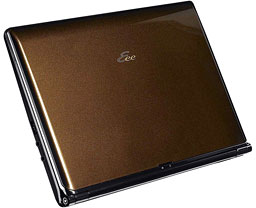 Of course, what the Eee PC S101 doesn't have is the Mac OS,
being available with either Microsoft Genuine Windows XP Home or GNU
Linux operating systems, the latter which comes with over 50
preinstalled applications. It gets along with a relatively poky
(presumably 1.6 GHz, although Asus isn't telling) Intel Atom processor
and and two-generations-ago Intel 945 Express (GMA 950) graphics, as
opposed to the MacBook Air's full-fledged Core 2 Duo CPU and GMA X3100
graphics.
Of course, what the Eee PC S101 doesn't have is the Mac OS,
being available with either Microsoft Genuine Windows XP Home or GNU
Linux operating systems, the latter which comes with over 50
preinstalled applications. It gets along with a relatively poky
(presumably 1.6 GHz, although Asus isn't telling) Intel Atom processor
and and two-generations-ago Intel 945 Express (GMA 950) graphics, as
opposed to the MacBook Air's full-fledged Core 2 Duo CPU and GMA X3100
graphics.
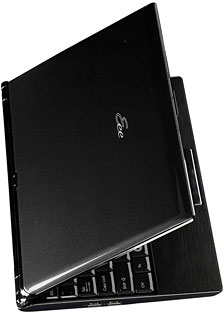 To recap,
the MacBook Air's several strong points are the Mac OS, a larger (13.3"
1280 x 800 resolution) display, a Core 2 Duo processor, and a
full-sized keyboard, but Apple made too many compromises with
connectivity, expandability, and practicality in their quest to make
the MacBook Air fit comfortably inside a manila envelope, resulting in
a machine that I wouldn't even consider owning (unless I became
unexpectedly flush with disposable income and could afford one as an
engaging toy), while the much-cheaper Asus (et al) netbooks are real
computers that I could conceive of using for the same sort of
production work that I do now with my old Pismo PowerBooks.
To recap,
the MacBook Air's several strong points are the Mac OS, a larger (13.3"
1280 x 800 resolution) display, a Core 2 Duo processor, and a
full-sized keyboard, but Apple made too many compromises with
connectivity, expandability, and practicality in their quest to make
the MacBook Air fit comfortably inside a manila envelope, resulting in
a machine that I wouldn't even consider owning (unless I became
unexpectedly flush with disposable income and could afford one as an
engaging toy), while the much-cheaper Asus (et al) netbooks are real
computers that I could conceive of using for the same sort of
production work that I do now with my old Pismo PowerBooks.
If the S101 was (legally) supported by Mac OS X, the choice
between the two machines would be a no-brainer for me, and I hear that
Linux is getting better all the time.
I think all of the S101's three available colors look great (make
mine a brown one), and I prefer the look to the MacBook Air's , but I
could do without the sequins.
Apple needs a laptop like this running OS X.
Will we get one tomorrow at an $800 price point? Not much longer to
wait before we find out.


 Consequently, netbooks are a marketing phenomenon Apple can't
afford to ignore, with
Consequently, netbooks are a marketing phenomenon Apple can't
afford to ignore, with  Apple
needs to cover this vulnerability, if not in tomorrow's announcement,
at least by Macworld Expo in January, if it wants to maintain its
laptop momentum (at least proportionately) in what will almost
certainly be a shrinking personal computer market over the next year or
two.
Apple
needs to cover this vulnerability, if not in tomorrow's announcement,
at least by Macworld Expo in January, if it wants to maintain its
laptop momentum (at least proportionately) in what will almost
certainly be a shrinking personal computer market over the next year or
two. The
S101 trounces the Air in terms of most aspects and features. It
supporting not only WiFi 802.11n and Bluetooth 2.0 connectivity, but
also including a VGA port (D-sub 15-pin for external monitor), 3 USB
2.0 ports (to the MacBook Air's overworked single USB port), a real
RJ-45 ethernet port, analog headphone and mic-in jacks, a 0.3 megapixel
(MP) camera, a 4-in-1 card reader (MMC, SD, Memory Stick, and MS-PRO
flash card), built-in stereo speakers, and a digital array mic. Its 36
W/hr; 2S2P (2450 mAh/cell) Polymer battery is slide-in replaceable (you
can change the battery yourself without undoing 19 screws) and offers a
claimed "up to five hours" of continuous use.
The
S101 trounces the Air in terms of most aspects and features. It
supporting not only WiFi 802.11n and Bluetooth 2.0 connectivity, but
also including a VGA port (D-sub 15-pin for external monitor), 3 USB
2.0 ports (to the MacBook Air's overworked single USB port), a real
RJ-45 ethernet port, analog headphone and mic-in jacks, a 0.3 megapixel
(MP) camera, a 4-in-1 card reader (MMC, SD, Memory Stick, and MS-PRO
flash card), built-in stereo speakers, and a digital array mic. Its 36
W/hr; 2S2P (2450 mAh/cell) Polymer battery is slide-in replaceable (you
can change the battery yourself without undoing 19 screws) and offers a
claimed "up to five hours" of continuous use. Of course, what the Eee PC S101 doesn't have is the Mac OS,
being available with either Microsoft Genuine Windows XP Home or GNU
Linux operating systems, the latter which comes with over 50
preinstalled applications. It gets along with a relatively poky
(presumably 1.6 GHz, although Asus isn't telling) Intel Atom processor
and and two-generations-ago Intel 945 Express (GMA 950) graphics, as
opposed to the MacBook Air's full-fledged Core 2 Duo CPU and GMA X3100
graphics.
Of course, what the Eee PC S101 doesn't have is the Mac OS,
being available with either Microsoft Genuine Windows XP Home or GNU
Linux operating systems, the latter which comes with over 50
preinstalled applications. It gets along with a relatively poky
(presumably 1.6 GHz, although Asus isn't telling) Intel Atom processor
and and two-generations-ago Intel 945 Express (GMA 950) graphics, as
opposed to the MacBook Air's full-fledged Core 2 Duo CPU and GMA X3100
graphics. To recap,
the MacBook Air's several strong points are the Mac OS, a larger (13.3"
1280 x 800 resolution) display, a Core 2 Duo processor, and a
full-sized keyboard, but Apple made too many compromises with
connectivity, expandability, and practicality in their quest to make
the MacBook Air fit comfortably inside a manila envelope, resulting in
a machine that I wouldn't even consider owning (unless I became
unexpectedly flush with disposable income and could afford one as an
engaging toy), while the much-cheaper Asus (et al) netbooks are real
computers that I could conceive of using for the same sort of
production work that I do now with my old
To recap,
the MacBook Air's several strong points are the Mac OS, a larger (13.3"
1280 x 800 resolution) display, a Core 2 Duo processor, and a
full-sized keyboard, but Apple made too many compromises with
connectivity, expandability, and practicality in their quest to make
the MacBook Air fit comfortably inside a manila envelope, resulting in
a machine that I wouldn't even consider owning (unless I became
unexpectedly flush with disposable income and could afford one as an
engaging toy), while the much-cheaper Asus (et al) netbooks are real
computers that I could conceive of using for the same sort of
production work that I do now with my old 
